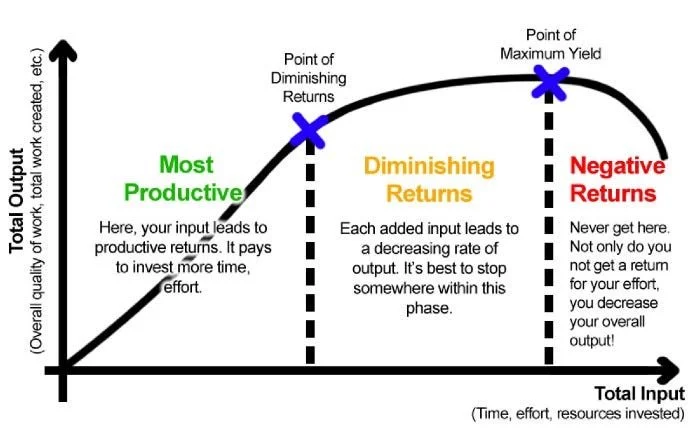The Minimum Effective Dose Approach to Productivity and Health
The grind and hustle culture have take our society by storm the last several years.
For many there is the mindset of doing more=getting more but that is not actually the case.
Work longer=deserve a bigger paycheck
More time in gym= more progress
Less food=More fat loss
And the list goes on.
But the truth is, we only need one example of the opposite for any of these to be disproven.
People win the lottery all the time which means more work doesn't mean you deserve more money.
People spend a lot of time in the gym with nothing to show for it.
Less food over a prolonged period of time and your fat loss will stall.
So where's the balance?
More importantly, what is not knowing the balance costing you?
Today I want to discuss an idea called the minimum effective dose (MED)
This was made popular by blogger, author and podcaster Tim Ferriss in his book The 4 Hour Body.
The minimum effective dose is defined as the smallest dose needed for a specific outcome.
Here is an example;
“To boil water, the minimum effective dose is 212 degrees Fahrenheit (100 degrees Celsius) at standard air pressure. Boiled is boiled. Higher temperatures will not make it “more boiled.” Higher temperatures just consume more resources that could be used for something else more productive.”
And here lies the problem for many.
The goal isn't to do as much as possible to get a result, its to do only what is needed to get the result.
It's about getting the most out of what you are doing. Efficiency, not working harder and longer.
I realize this may still be hard to wrap your head around.
So lets take a further look.
Take a look at the chart below that illustrates this.
Lets equate this to your fitness journey.
You know to lose weight you must be in a caloric deficit.
For simplicity lets say you need to eat 2000 calories a day to maintain your weight.
So you cut calories by 300 to be in a deficit and you now exercise 30 minutes a day.
You are burning now 2500 calories per day while eating 1700 (800 calorie deficit per day.)
You are in a deficit of 5600 calories per week (800 per day x 7 days in a week) which equates to over 1lb of fat per week (3800 calories in 1 lb of fat)
This is manageable. (most productive)
But you want to lose more and quicker!
So you exercise everyday for 90 minutes while also slashing calories further.
Lets say your body now burns a total of 3500 calories in a day and you eat 1200 calories instead of 1700.
Comparatively, your input of calories is very little, while your output of calories burned is very high.
Initially you may see fast progress but this will bring you "diminishing returns" very quickly because the balance is off.
There is a gap of 2300 calories. This gap is very large, and will be very stressful.
The stress response shows up in the form of low energy, low libido, bad sleep, more hunger and cravings.
To compensate your body will stop burning fat altogether. (negative returns)
Combine the stress responses above with stalled fat loss and you understand why most people quit.
As you can see, more isn't better here and in fact is often why so many people fail (96%)
When it comes to diet and fat loss I have written about a good starting spot in a previous blog, you can view that here.
They key is finding that balance. You find that balance by understanding that health and fitness is an infinite game and not a game you win in 3 or 4 months.
Trying to do more than you can manage will always results in burnout and frustration. These are hardly a good combo when trying to change your life.
Instead, reflect on where you are currently at in these 3 areas, and aim to make progress.
1. Food. How much are you eating? What kind of foods are you eating?
Once you identify where you are at, identify one step forward.
Ex. You overeat in calories and drink high sugar sodas. Instead, drink diet soda and as a result eliminate extra calories.
2. Movement. How active are you throughout the day?
0-2k steps per day?
2-4k steps a day?
4-6k steps a day?
6-10k steps a day?
Identify where you are at and move one up the ladder. If you are at 2-4k then look at getting 4-6k over the next 30 days. Then move up. Going from 2k to 10k overnight will likely result in frustration as we outlined.
3. Exercise. How often are you doing resistance training?
0 days a week? 1-2 days? 2-3 days? 3-5 days?
Move up the ladder 1 to start.
Research shows that eating an appropriate amount of calories from the right sources combined with an active lifestyle (6-10k steps per day) and resistance training often (3-5x a week) will result in a better quality of life.
Don't worry about getting there overnight, just make it a goal over the next several months and year.
Remember, its a long game and you must treat it as such.
Hope this was useful.
PS. As always, if you need help making this a part of your life, you can apply to work together through the link below.


